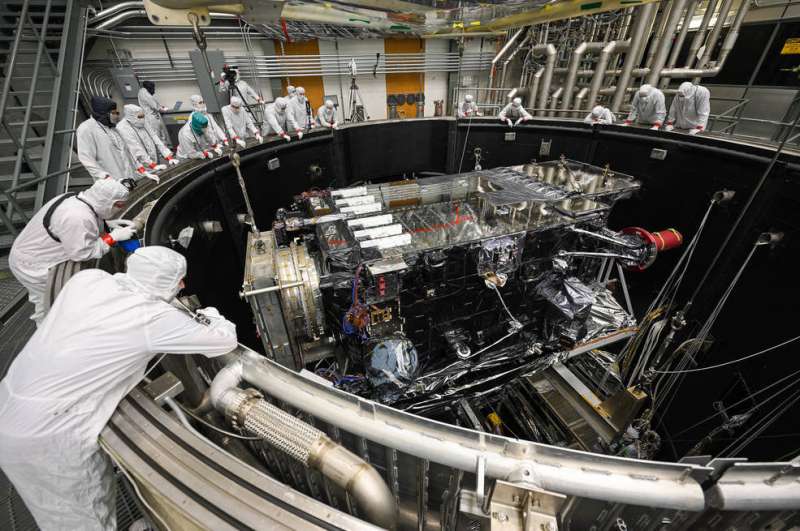
NOAA’s GOES-U, the final satellite in the GOES-R Series of advanced geostationary environmental satellites, recently completed thermal vacuum (TVAC) testing as part of a rigorous assessment program to ensure the satellite can withstand the harsh conditions of launch and orbiting 22,236 miles above Earth’s equator. The testing is taking place at Lockheed Martin Space’s Littleton, Colorado, facility, where GOES-U was built.
The GOES-R program is a collaborative effort between NOAA and NASA. NASA builds and launches the satellites for NOAA, which operates them and distributes their data to users worldwide. The satellites provide critical data for weather forecasts and warnings, detecting and monitoring environmental hazards like fire, smoke, fog, volcanic ash, and dust, and monitoring solar activity and space weather.
During TVAC testing, GOES-U was placed in a large 29 feet by 65 feet chamber and subjected to a vast range of temperatures, soaring as high as 188 degrees Fahrenheit and dropping as low as minus 67 degrees Fahrenheit, to simulate the extreme temperatures of launch and the space environment. The fully integrated GOES-U satellite went through four cycles of TVAC, thoroughly testing the spacecraft bus and all seven instruments.
Next, GOES-U will undergo vibration testing, which mimics the stresses it will experience during launch, to ensure the satellite’s structure has been designed and built to successfully deliver the instruments to orbit. GOES-U will also endure extremely high sound pressure of 138.4 decibels from high-intensity horns during acoustic testing, which will simulate the noises GOES-U will experience during launch. Shock testing will ensure the satellite can withstand the shocks encountered during separation from the launch vehicle and deployment of its solar panels. Finally, electromagnetic interference/compatibility testing will ensure electromagnetic radiation in space will not damage the satellite.
At specific points during the environmental testing, the Mission Operations Support Team conducts end-to-end tests that command the satellite from the ground system. These end-to-end (ETE) tests validate the compatibility of flight and ground hardware, software, and communications interfaces in a mission operations context. Two GOES-U ETE tests are complete, and the team will conduct three additional ETE tests in 2023 and 2024.
GOES-U will continue the advanced imaging, lightning mapping, and space weather monitoring its sister satellites in the GOES-R Series provide and will also carry a new space weather monitoring instrument.
The Compact Coronagraph (CCOR) will image the solar corona (the outer layer of the sun’s atmosphere) to help detect and characterize coronal mass ejections (CMEs). CMEs are large expulsions of plasma from the corona and are the primary cause of geomagnetic storms, which can cause widespread damage to power grids, satellites, and communication and navigation systems on Earth.
GOES-U, the final satellite in the GOES-R Series, is scheduled to launch in April 2024 from Cape Canaveral Space Force Station in Florida. The satellite will be renamed GOES-19 once it reaches geostationary orbit, approximately two weeks after launch.
The GOES-R Program is a four-satellite mission that includes GOES-R (GOES-16, launched in 2016), GOES-S (GOES-17, launched in 2018), GOES-T (GOES-18, launched in 2022), and GOES-U.
The GOES-R Series satellites are planned for operation into the 2030s. NOAA and NASA have begun work on the next-generation geostationary mission called Geostationary Extended Observations (GeoXO). GeoXO will continue observations provided by GOES-R and bring new capabilities to address our changing planet and the evolving needs of NOAA’s data users.
Provided by
NASA
NOAA’s GOES-U completes thermal vacuum testing (2022, November 22)
retrieved 23 November 2022
from https://phys.org/news/2022-11-noaa-goes-u-thermal-vacuum.html
part may be reproduced without the written permission. The content is provided for information purposes only.